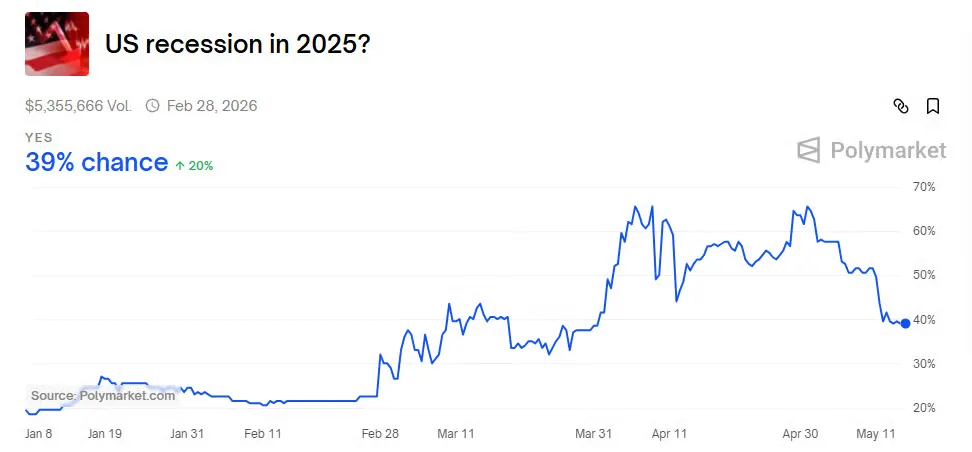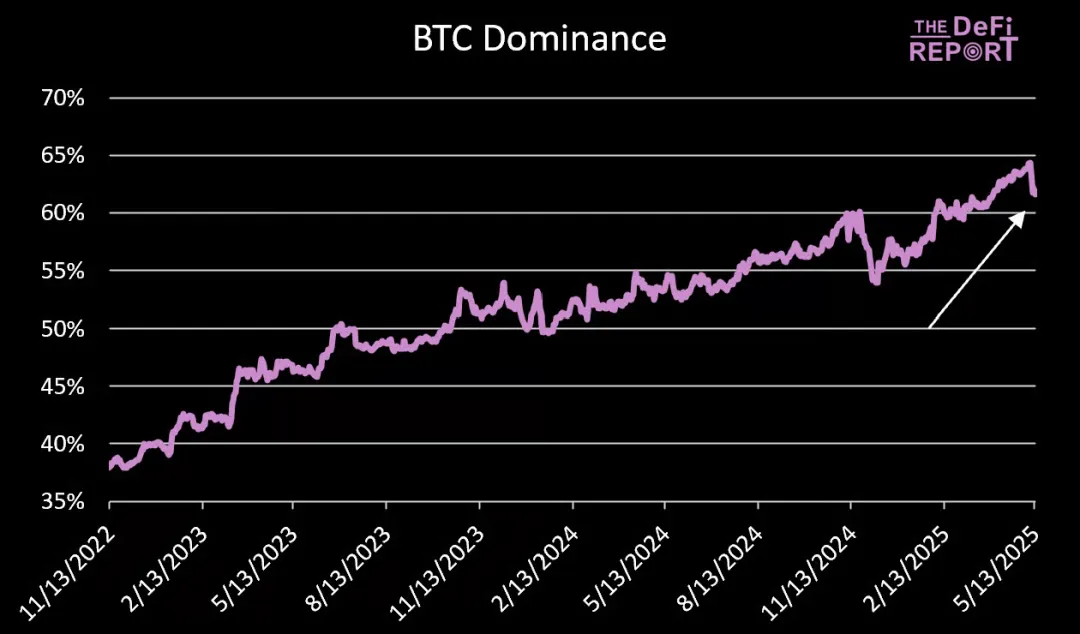We have been monitoring the key support area of Bitcoin (BTC), planning to either exit the market (expecting further decline) or redeploy funds to higher-risk assets when cash flow allows, anticipating a possible "Altcoin season" or market peak later this year.
Editor's Note:
From the dramatic shift in Trump's tariff policies to the recession risks hidden in soft U.S. economic data, global markets have been fluctuating driven by liquidity and sentiment. Meanwhile, Bitcoin seems to be brewing a new high, and the entire market seems to be able to smell the "Altcoin season".
So, what is the current market situation, and could Bitcoin's dominance rate have peaked? Is the "Altcoin season" really coming? This article will give you an overview from the perspective of data indicators.
We have been monitoring the key support area of Bitcoin (BTC), planning to either exit the market (expecting further decline) or redeploy funds to higher-risk assets when cash flow allows, anticipating a possible "Altcoin season" or market peak later this year.
Next, we will discuss how we manage risks against the backdrop of tariffs and improved market sentiment.
01\Macroeconomic
Tariffs
We initially believed that the Trump administration would take a tough stance on China while negotiating with other countries. When Trump raised tariffs to 145%, this view seemed correct. Of course, this actually created unsustainable trade barriers between the world's two largest economies.
Now, we see tariffs on China are limited to 30% with a 90-day pause. The market reacted strongly to this news. But it needs to be understood that the global effective tariff rate is still 17.8%, compared to just 2.5% when Trump took office.
Looking Forward
We cannot predict the short-term trend of tariffs, and attempting to do so would be futile. But it can be said that traders who bought when Trump said "buy" and sold when he said "sell" in the past few months may have made a fortune.
Long-term readers know this is not our investment style. We look forward to returning to long-term thinking. At the same time, short-term perspectives are necessary in the later stages of a cycle.
From a long-term perspective, we try to focus on the big picture:
- Tariff rates will not return to 2.5%.
- Tariffs are mainly to rebalance trade with China (power struggle) while catering to Trump's populist base (bringing manufacturing back to the U.S.). Two birds with one stone.
Economic Recession
Before the 90-day tariff pause on China, soft data (surveys) showed an increased risk of recession:
- ISM Manufacturing Index fell to 48.7 in April (business cycle contraction), although services rose to 51.7 (expansion).
- University of Michigan Consumer Confidence Index was 52.2 in April, far below the long-term average of 85 (71 during the COVID peak).
- One-year inflation expectations rose to 6.5% in April (University of Michigan survey).
- March Challenger report showed layoffs at the highest level since the Great Recession, with a slight decline in April but still 63% higher than last year.
- Los Angeles port data shows a 30% decrease in cargo volume from China, expected to impact retail in May/June.
Overall, Polymarket set the recession probability at 66% on May 1st (now 40%).

Data source: Polymarket
We believe soft data will eventually be reflected in hard data (actual data) - currently, hard data still shows a strong economy.
Now, with a 90-day tariff pause, we believe short-term recession concerns have eased.
The question is how long this "wall of worry" can be climbed until another wave of negative news dampens expectations.
This could happen tomorrow, no one knows, making the current market more like a trader's market.
Nevertheless, there seems to be a window of rising risk appetite in the short term, and capital allocators may need to chase the market.
02\Crypto Market
Rising risk appetite is most evident in the crypto market, which is the most sensitive asset class to liquidity conditions.
The crypto market seems to smell the following trends:
- U.S. government fiscal spending has not decreased, still over 7% of GDP.
- Government and corporate debt will face a refinancing wave of $3.5-4 trillion in the third and fourth quarters.
- Possible tax cuts, regulatory relaxation, and SLR adjustment (potentially increasing bank leverage/liquidity) later this year.
- Inflation is declining (this week's CPI and PPI reports show inflation slowing), which could give the green light for Fed rate cuts.
Overall, liquidity conditions are favorable, as the Fed may need to buy some of the upcoming refinancing and new debt issuance.
These factors increase the possibility of an "Altcoin season", even though the Fed is currently staying put.
For the first time since the fourth quarter of last year, we observe a sustained rise in Altcoins and meme coins. Meanwhile, Bitcoin's dominance rate seems to have peaked:

Data source: glassnode, The DeFi Report
Altcoin Season
If we truly enter an "Altcoin season", the Bitcoin dominance rate in the chart still has a long way to fall. This means (partial) Altcoins will perform excellently.
But how do we confirm an "Altcoin season"? Here are the key factors:
- The last year of the cycle.
- Bitcoin dominance rate starts at 65-70%.
- Shift from Quantitative Tightening (QT) to Quantitative Easing (QE).
- ETH/BTC ratio rises.
- Retail investor interest and "Meme" revival.
Currently, we are in the early stages of this process. ETH/BTC is still 0.024, and ETH/USD price is 46% below its historical high. The Fed is still implementing QT.
Nevertheless, ETH's 35% rise last week reminds of the 68% rise from January 1st to 7th, 2021 (from $729 to $1,224).
At that time, the ETH/BTC ratio rose from 0.03 to 0.07 four months later, with ETH/USD rising 370%.
This triggered a wave of Altcoins, Non-Fungible Tokens, metaverse tokens, and alternative Layer 1s. There was almost no pullback from January to May 2021. The market then crashed in mid-July (ETH dropped from $4,000 to $1,800), before reaching an all-time high in November.
Some Altcoins (like Terra Luna) continued to rise after BTC and ETH peaked, until the entire market collapsed.
This was the situation in the last cycle.
So, how do we approach the current situation?
03\Portfolio Management
We are satisfied with locking in profits on long-term positions in December/January. Since then, we have been monitoring the market, looking for signals: either the market crashes into a bear market or rebounds to form another peak.
We now lean towards the latter.
But this does not mean we are going all in.
As many readers know, our style is to wait for a "fat ball" (high-certainty opportunity). We do not consider the current situation a "fat ball", but we also believe there are upside risks.
Here is our strategy:
- We are not interested in BTC at current prices.
- Instead, we will reallocate a small portion of profits to higher-risk assets.
Historically, assets that perform well at the end of a cycle are early performers + emerging/shiny new things. Tokens with strong communities/narratives and low circulation may see the largest gains.
DeFi projects with strong fundamentals may also perform well, and we also expect top "blue-chip" meme coins to perform excellently.
04\Risks
I want to be clear that we are not going all in now. We just hope to capture some upside potential during a strong market rebound.
Risks to consider include:
- BTC needs to break through its historical high point. If this does not happen, our perspective may be irrelevant.
- Summer is usually a period of volatility/consolidation. Current sentiment is somewhat extreme and may lead to further declines similar to last year.
- Bond market. We believe long-term yields will eventually rise. The stock market (and cryptocurrencies) may rise during these periods, but valuations are ultimately determined by DCF calculations, and if this occurs, the stock market (and cryptocurrencies) will ultimately correct.
- Stablecoin legislation did not pass the Senate last week (Democrats continue to obstruct cryptocurrencies). This is important, and the crypto market may have underestimated its impact. If this legislation does not pass, larger crypto bills may also be blocked, creating headwinds for the asset class.
05\Summary
"Altcoin season" refers to over 50% of new inflows in the crypto market going to non-BTC assets. This does not mean all Altcoins will perform well.
Asset selection and timing are crucial.
Please understand that in addition to market risks, there are many other risks. Yesterday we learned that Coinbase user data was recently exploited. As prices rise, hacking, hidden leverage, and social engineering scams pose additional risks for crypto investors.
We believe there will be opportunities to buy BTC and other blue-chip assets at a discount in the near future. But we also want to have fun and try to capture the remaining upside potential of the current cycle.






